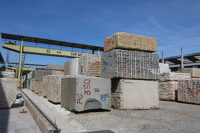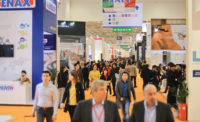Production — all of which carries the “Made in Italy” distinction — includes slabs measuring 305 x 140 cm (55 x 120 inches) and tiles up to 120 x 120 cm (48 x 48 inches).
Stone Italiana has two large manufacturing plants certified UNI EN ISO 9001:2000 — one in Zimella (Verona), producing large slabs for cut-to-size items and small slabs for tiles, and another in Villesse (Gorizia), also producing large slabs.
Over the years, Stone Italiana has tailored its production as a reflection of a new way of perceiving and using stone — rediscovering qualities such as uniqueness and variety while also not attempting to imitate nature. Rather, it seeks to draw inspiration from nature in order to develop new materials that offer improved performance to a discerning market.
With this in mind, experimentation is a top priority at Stone Italiana through all production steps — from aesthetic considerations to product performance.
Stone Italiana has an ongoing commitment to producing surfaces with enhanced mechanical strength along with reduced thickness and weight, and it is always experimenting with new colors and textures, while trying out different mixture compositions and grades.
In terms of custom work, Stone Italiana has a history of collaborating with architects, developers and designers who wish to experiment with new aesthetic solutions. It has developed special color shades and mixture grades, along with innovative inserts and textures and exclusive combinations of materials. Examples of this approach can be seen in the floors that it developed for Armani, Chloé, Pucci, Benetton, Fendi, Trussardi, Swatch and Deutsche Bank, among others.
Production
Stone Italiana’s production facilities utilize the Bretonstone Slab plants, which are made to produce slabs and tiles of compound stone bonded with polyester using a “vibrocompression vacuum process.”
The Stone Italiana product range is the result of a leading-edge controlled manufacturing process that is aimed to achieve products suitable for special applications in the building industry. These products consist of a composite material, which is mostly quartz- or marble-based.
The manufacturing process begins by mixing a combination of raw materials (quartz or marble) in various grain sizes (from fine dust up to 5- to 6-mm grit), organic dyes and structural polyester resin (approximately 7%). Besides acting as a binder, the resin allows for a finished product that displays excellent characteristics in terms of flexural strength, impact strength and a low absorption coefficient. The polyester resin is heat cured and, through a computerized industrial process of vibrocompression under vacuum at high pressure, it permits the manufacturing of large-format slabs (120 x 120 cm and 140 x 305 cm) in various thicknesses (1, 1.3, 2 and 3 cm thick), suited for a wide range of applications.
The processing cycle results in the production of individual slabs, thereby eliminating the need for any block cutting operations. The raw materials are first mixed and homogenized via computerized control units. The resulting mix is then poured between two paper sheets in the amount needed to get the desired thickness. From there, it is placed on a conveyor belt that delivers the product to the compaction area, where the mix is pressed into slabs.
Each slab is then cured in a curing chamber that consists of a tower-like structure with a number of heating trays, which are kept at a temperature in the region of 176 to 185 degrees (80 to 85 degrees C). Through heat treatment, the mixture pressed into a slab will solidify in approximately 30 to 40 minutes.
Finally, each slab is processed to the desired surface finish through a number of steps, including surface smoothing, calibrating, polishing, trimming, beveling and edge work, depending on the intended use.
Finished slabs from Stone Italiana can be supplied in very large quantities with controlled, quality-assured features, such as consistency in weight, thickness and compactness, and uniform design and color of the exposed surface.
The plant in Zimella, Verona, produces 30,000 square meters of slabs measuring 305 x 140 cm (55 x 120 inches) and 35,000 square meters of tiles ranging from 30 x 30 to 120 x 120 cm (12 x 12 to 48 x 48 inches) per month, along with production of the U Design engineered quartz sink collection.
Additionally, the plant in Villesse, Gorizia, produces 30,000 square meters of slabs measuring 305 x 140 cm (55 x 120 inches) per month.
Sales breakdown
At the latest tally, Stone Italiana’s sales were 68% slabs, 28% tiles and 3% other products. Among slab sales, a total of 53% was shipped within Italy, with 27% being shipped elsewhere within the European Community and 20% going to the rest of the world. For tile sales, a total of 30% was shipped within Italy, with 33% being shipped elsewhere within the European Community and 38% going to the rest of the world.
Internationally, main markets include Holland, Germany, Qatar, Hong Kong, the U.S., Russia, France, the U.K., Spain, Australia and Canada. It maintains a number of exclusive distributors for North America.
Among the company’s noteworth installations, Stone Italiana has supplied material for Armani on Fifth Avenue in New York, NY; Victoria’s Secret stores across North America; Gap stores across North America; Newark Liberty International Airport in New Jersey; the Dubai Metro Underground Stations; Shanghai Expo 2010 in China; and the Qatar Foundation University College in Doha.
|
Stone Italiana Timeline |
|
1979: Stone Italiana is established in Zimella, near Verona, manufacturing recomposed marble. 1981: First supply of a raised access flooring system called Stonit. 1982: The “Uniform White” concept embodied by the Almond White collection meets with huge success. This product line is presented at the Salone del Mobile in Milan. 1983: First supplies of ventilated facades for Bank Institutions located in Padua and Prato, Italy. 1984: Stone Italiana supplies the flooring for Schiphol Airport, Amsterdam. 1985: Stone Italiana’s Filidoro collection is an award winner at the Saiedue Exhibition in Bologna. 1988: A subsidiary called Niston is established at Lavis, near Trento. It manufactures recomposed granite slabs. 1990: New commercial offices are opened at San Martino Buon Albergo, near Verona. 1992: Stone Italiana’s products are chosen for the Deutsche Bank branches in Germany. 1994: First meeting with Italcementi, leading to an agreement for the introduction of 300-x 120-cm recomposed quartz slabs. 1995: Initial proposals for the supply of Stone Italiana products to German Mail and Railway, in cooperation with Milan-based Studio De Lucchi. 1996: Production of 300- x120-cm recomposed quartz slabs is increased and extended to encompass other applications in addition to floors, such as kitchen countertops, vanities, stairs and more. 1997: Stone Italiana takes over Polistone, a company headquartered in Villesse, near Gorizia. The company manufactures exclusively large-format recomposed quartz slabs. The Niston subsidiary is sold. 1998: New administrative and commercial offices are opened in the heart of Verona’s business district (Palazzo Bauli). 1999: The company introduces Cottostone, a revolutionary, world-patented surfacing material developed jointly with Sannini Impruneta. Stone Italiana’s technology made it possible to manufacture cotto slabs in a size of 300 x 120 cm. 2000: Reduced-thickness slabs (as thin as 6 mm) and a new surface finish called Nat are introduced. 2001: The company starts production of 75- x 300-cm slabs in various thicknesses, primarily for the kitchen countertop market. 2002: Stone Italiana strengthens its presence at retailers worldwide, providing them with customized tools and showroom support. 2003: Stone Italiana’s range is complemented with three new collections: Luce, Absolute and Jaipur. 2004: As it celebrates its 25th anniversary, Stone Italiana achieves ISO 9001:2000 Certification for Quality Management. At the same time, it takes great steps forward in technology and production. It creates the Metallico collection by mixing quartz with scrap from the microelectronics industry and patents an anti-static and dissipative floor — the first ever in its class. 2005: Stone Italiana is selected by the Italian Government to supply the floor for the Italian Pavilion at the International Expo in Aichi, Japan. 2006: Stone Italiana introduces its Bathroom Collection, a new product line especially designed for the bathroom. It allows the creation of customized bathrooms through the use of new materials, new formats and innovative decorations. 2007: Stone Italiana widens its product range with Mosaico Italiano, a collection of mosaic tiles, which come pre-grouted. This offers a solution to the problems connected with the installation of mosaic tiles. 2008: Stone Italiana introduces its Luxury Collection, a new collection of precious quartz surfaces featuring semi-precious gems (Fire Agathe, Sodalite, Jadeite, Rosequartz, Amethyst, Red Jasper), complemented by a matching color shade for each one of the six gems. 2009: Stone Italiana doubles its production by opening a new plant and offices at Zimella, near Verona. The company celebrates its 30th anniversary by opening the very first “All-Quartz” showroom in Europe, based in Milan. 2010: Stone Italiana products continue to be chosen for top projects such as Dubai Underground stations, Shanghai Expo, Armani Fifth Avenue in New York, and more. 2011: The company introduces its revolutionary U Design collection, the first range of one-piece quartz sinks.
|













